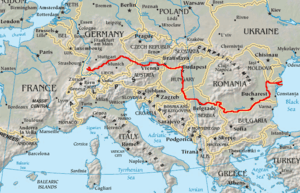Passau
Passau (German pronunciation: [ˈpasaʊ] (![]()
Passau | |
|---|---|
 Donaulände and Old town | |
 Coat of arms | |
Location of Passau 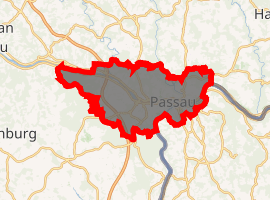
| |
 Passau  Passau | |
| Coordinates: 48°34′0″N 13°28′0″E | |
| Country | Germany |
| State | Bavaria |
| Admin. region | Niederbayern |
| District | Urban district |
| Government | |
| • Lord Mayor | Jürgen Dupper (SPD) |
| Area | |
| • Total | 69.58 km2 (26.86 sq mi) |
| Highest elevation | 447 m (1,467 ft) |
| Lowest elevation | 294 m (965 ft) |
| Population (2018-12-31)[1] | |
| • Total | 52,469 |
| • Density | 750/km2 (2,000/sq mi) |
| Time zone | CET/CEST (UTC+1/+2) |
| Postal codes | 94001–94036 |
| Dialling codes | 0851 |
| Vehicle registration | PA |
| Website | www.passau.de |
Passau's population is 50,000, of whom about 12,000 are students at the University of Passau, renowned in Germany for its institutes of economics, law, theology, computer science and cultural studies.[2]
History
In the 2nd century BC, many of the Boii tribe were pushed north across the Alps out of northern Italy by the Romans. They established a new capital called Boiodurum by the Romans (from Gaulish Boioduron), now within the Innstadt district of Passau.[3]
Passau was an ancient Roman colony called Batavis, Latin for "for the Batavi." The Batavi were an ancient Germanic tribe often mentioned by classical authors, and they were regularly associated with the Suebian marauders, the Heruli. Batavis (Passau-Altstadt) was a Roman castrum in the province of Raetia, while another late Roman castrum, Boiotro (Passau-Innstadt), was in the province of Noricum.
During the second half of the 5th century, St. Severinus established a monastery here. The site was subject to repeated raids by the Alemanni.[4] In 739, an English monk called Boniface founded the diocese of Passau, which for many years was the largest diocese of the German Kingdom/Holy Roman Empire, covering territory in southern Bavaria and most of what is now Upper and Lower Austria. From the 10th century the bishops of Passau also exercised secular authority as Prince-Bishops in the immediate area around Passau (see Prince-Bishopric of Passau).
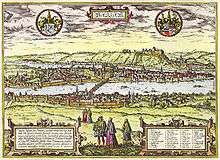
In the Treaty of Passau (1552), Archduke Ferdinand I, representing Emperor Charles V, secured the agreement of the Protestant princes to submit the religious question to a diet. This led to the Peace of Augsburg in 1555.
During the Renaissance and early modern period, Passau was one of the most prolific centres of sword and bladed weapon manufacture in Germany (after Solingen). Passau smiths stamped their blades with the Passau wolf, usually a rather simplified rendering of the wolf on the city's coat-of-arms. Superstitious warriors believed that the Passau wolf conferred invulnerability on the blade's bearer, and thus Passau swords acquired a great premium. According to the Donau-Zeitung, aside from the wolf, some cabalistic signs and inscriptions were added.[5] As a result, the whole practice of placing magical charms on swords to protect the wearers came to be known for a time as "Passau art". (See Eduard Wagner, Cut and Thrust Weapons, 1969.) Other cities' smiths, including those of Solingen, recognized the marketing value of the Passau wolf and adopted it for themselves. By the 17th century, Solingen was producing more wolf-stamped blades than Passau was.
In 1662, a devastating fire consumed most of the city. Passau was subsequently rebuilt in the Baroque style.
Passau was secularised and divided between the Electorate of Bavaria and the Electorate of Salzburg in 1803. The portion belonging to Salzburg became part of Bavaria in 1805.
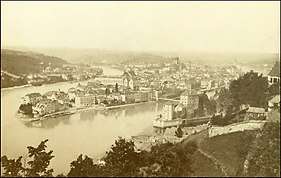
From 1892 until 1894, Adolf Hitler and his family lived in Passau.[6] The city archives mention Hitler being in Passau on four occasions in the 1920s for speeches. In addition, Heinrich Himmler spent some time there.
In November 1933, the building of Nibelungenhalle (Hall of the Nibelungs) was announced. Intended to hold 8,000 to 10,000 guests, and another 30,000 in front of it, in 1935 the hall also became quarters for a unit of the Austrian Legion.[7] Beginning in 1934, these troops had occupied a building that belonged to Sigmund Mandl, a Jewish merchant. That building, in turn, was referred to as SA barracks.[8]
Beginning in 1940, Passau offered the building at Bräugasse 13 to Volksdeutsche Mittelstelle.[9]
During World War II, the town also housed three sub-camps of the infamous Mauthausen-Gusen concentration camp: Passau I (Oberilzmühle),[10] Passau II (Waldwerke Passau-Ilzstadt) and Passau III (Jandelsbrunn). From January to May 1945, refugees from East Prussia and Silesia passed the city, after May, as the result of Ethnic cleansing of neighboring Bohemia and Moravia off its German populace, further waves of refugees arrived in the town.[11]
On May 3, 1945, a message from Major General Stanley Eric Reinhart’s 261st Infantry Regiment stated at 3:15 am: "AMG Officer has unconditional surrender of PASSAU signed by Burgermeister, Chief of Police and Lt. Col of Med Corps there. All troops are to turn themselves in this morning."
It was the site of a post World War II American sector displaced persons camp.
On 2 June 2013, the old town suffered from severe flooding as a result of several days of rain and its location at the confluence of three rivers [12] Peak elevations of floods as early as 1501 are displayed on a wall at the Old City Hall.[13] Flood water reaches the base of that wall on average once every 5 years.[13]:19
Subdivisions
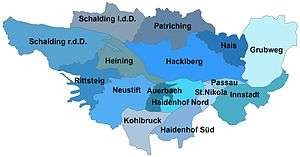
Until 2013, the City of Passau was subdivided into eight statistical districts, which in general coincide with formerly separate municipalities. Since 2013, the city is divided in 16 so-called areas of open council ("Bürgerversammlungsgebiete").
Main sights
Many river cruises down the Danube start at Passau and there is a cycling path all the way down to Vienna. It is on the designated heritage route, the Route of Emperors and Kings.[14]
Passau is notable for its gothic and baroque architecture. The town is dominated by the Veste Oberhaus and the Veste Niederhaus, both parts of the former fortress of the Bishop, on the mountain crest between the Danube and the Ilz.
Tourism in Passau focuses mainly on the three rivers, the St. Stephen's Cathedral (Der Passauer Stephansdom) and the "Old City" (Die Altstadt).
With 17,774 pipes and 233 registers,[15] the organ at St. Stephen's was long held to be the largest church pipe organ in the world and is today second in size only to the organ at First Congregational Church of Los Angeles, which was expanded in 1994. Organ concerts are held daily between May and September. St.Stephen's is a true masterpiece of Italian Baroque, built by Italian architect Carlo Lurago and decorated in part by Carpoforo Tencalla.
Among many other churches are the Jesuits church of St. Michael, the oldest parish church of St. Paul and the pilgrim church Mariahilf on the hill south of the rivers Inn and Danube.
Before the cathedral is a large square (Domplatz) with the Lamberg-Palais, where the Peace of Passau was concluded. The medieval Old Residence south of the cathedral and the baroque New Residence further west at Residenzplatz were the palaces of the Prince-Bishops within the town. Right beside the 14th century Gothic Town Hall with its neo Gothic tower and the big 19th century former Hauptzollamtsgebäude (Main Customs Office) at the Danube is the Scharfrichterhaus, an important jazz and cabaret stage on which political cabaret is performed.


Migrant entry point
Due to its location on the German-Austrian border, and in the south-east of the country, Passau has become a major migrant entry point into Germany. Refugees and economic migrants from the Middle East, Asia and Africa who have reached Europe, often entering either overland via Greece or across the sea via the Mediterranean (see Operation Triton), then head north and sometimes enter Germany. In 2015 the BBC reported that traffickers drive migrants and refugees through Austria and leave them on the side of the autobahn. The migrants and refugees then often walk unaccompanied into Passau, the first German town northwards. This situation has caused the government of Passau to divert funds from flood prevention to housing and feeding the refugees and migrants, around 10% of whom are unaccompanied children.[16]
Twin towns - sister cities
Passau is twinned with:[17]









Notable people
- Michael Ammermüller (born 1986), a race car driver.
- Joseph Ferdinand Damberger (1795–1859), historian.
- Alfred Dick (1927–2005), a Bavarian politician.
- Hans Fruhstorfer (1866–1922), explorer, insect trader and entomologist, born in Passau.
- Albert Ganzenmüller (1905–1996), who served from 1942 to 1945 as the state secretary of the Reich Transportation Ministry, born in Passau.
- Henry Gerber (1892−1972), early U.S. gay rights activist, born in Passau.
- Adolf Hitler and his family, Passau residents for two years from 1892 to 1894.
- Nicolaus A. Huber (born 1939), composer.
- Bruno Jonas (born 1952), a cabaret artist and actor.
- Joseph Maximilian Ritter von Maillinger (1820–1901), Bavarian general and war minister, born in Passau.
- Gottlieb Muffat (1690–1770), organist and composer.
- Otto of Passau, medieval German clerical author
- Anna Rosmus (born 1960), controversial German author, Third Reich historian.
- Christian Rub (1886–1956), actor, born in Passau.
- Andreas Scheuer (born 1974), politician (CSU)
- Ludwig Schmidseder (1904–1971), composer and pianist.
- Heidi Schüller (born 1950), a West German athlete.
- Florian Silbereisen (born 1981), German singer and television presenter.
- Gisela Mashayekhi-Beer, Austrian flautist
- Georg Philipp Wörlen (1886–1954), painter.
References
- "Fortschreibung des Bevölkerungsstandes". Bayerisches Landesamt für Statistik und Datenverarbeitung (in German). July 2019.
- "Wir über uns" [About Us]. Passau University: Catholic Theology Faculty. Archived from the original on 2007-12-13.
- Collis, John (2003). The Celts: Origins, Myth and Inventions. Tempus Publishing. ISBN 978-0752429137.
- Drinkwater, John F. (2007). The Alamanni and Rome 213-496 (Caracalla to Clovis). Oxford University Press. ISBN 978-0-19929568-5.
- Rosmus, Anna. Hitlers Nibelungen, Samples Grafenau 2015, pp. 201
- Rosmus, Anna. Hitlers Nibelungen, Samples Grafenau 2015, pp. 20f
- Rosmus, Anna. Hitlers Nibelungen, Samples Grafenau 2015, pp. 98-101
- Rosmus, Anna. Hitlers Nibelungen, Samples Grafenau 2015, pp. 102f
- Rosmus, Anna. Hitlers Nibelungen, Samples Grafenau 2015, pp. 241ff
- Rosmus, Anna. Hitlers Nibelungen, Samples Grafenau 2015, pp. 207f
- Egon Harings (2019). Vertreibung aus Mähren: Der Todesmarsch von Brünn. tredition.
- "Floods threaten Dresden as Prague river levels fall". BBC News. 4 June 2013.
- Eychaner, James H. (2015). "Lessons from a 500-year record of flood elevations" (PDF) (Technical Report 7 ed.). Madison, Wisconsin: Association of State Floodplain Managers. Retrieved 28 September 2018. Cite journal requires
|journal=(help) - "The Route of Emperors and Kings".
- "Europe's Largest Pipe Organ". Atlas Obscura. Retrieved 28 September 2018.
- Hill, Jenny (19 June 2015). "Passau in Germany struggles to support asylum seekers". BBC News.
- "Partnerschaften und Städtefreundschaften". passau.de (in German). Passau. Retrieved 2019-11-23.
Further reading
- Huber, Gerald (2010). Kleine Geschichte Niederbayerns: überarbeitete und ergänzte Auflage. Regensburg: Friedrich Pustet. ISBN 978-3-7917-2048-7.
- Wagner, Christoph (2007). Entwicklung, Herrschaft und Untergang der nationalsozialistischen Bewegung in Passau 1920 bis 1945. Berlin: Frank & Timme. ISBN 978-3-86596-117-4. Passau, Universität, Dissertation, 2005
- Weithmann, Michael W. (2004). Kleine Passauer Stadtgeschichte. Regensburg: Friedrich Pustet. ISBN 978-3791718705.
- Jeep, John M., ed. (2001). "Passau". Medieval Germany: an Encyclopedia. Garland Publishing. ISBN 978-0824076443.
External links
| Wikimedia Commons has media related to Passau. |
| Wikivoyage has a travel guide for Passau. |
- Official website

- Passau Wiki (in German)
- Passau at Flickr
- Passau Cathedral, which is famous for its organ with 17,774 pipes and 233 registers - the biggest church organ on Earth - Zoomable map and satellite overview (Google Maps).
- First stop for new arrivals in Germany: bureaucracy (My Way news, September 16th, 2015)
